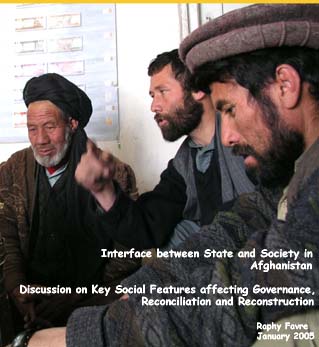Interface
between State and Society

The hypothesis of this discussion paper is
that the failure of successive government administrations
in Afghanistan is partly due to a failed interface between
the State apparatus and the Society. Therefore, the form of
interaction between the new government and the Afghan society
will determine how successful this administration will perform
as compared to the previous ones. The paper analyzes the notions
of ”qawm” and “manteqa” which are common characteristics of
the Afghan society and their implications in the relation
between the State and the Society. The administrative structure
of the government of Afghanistan is divided into provinces,
districts and villages. However, no mapping or listing has
captured the complexity of villages in Afghanistan, particularly
as the notion of village is unclear and bound to a variety
of interpretation. This lack of clear interface has hampered
the interaction between the State and the Society in the past.
The “manteqa”, or the territorial unit of social groups in
rural Afghanistan, does not have administrative recognition,
although traditional structures/committees exist at the “manteqa”
level (i.e. “shura-e mahali”, “shura-e manteqa”, “rish safedan-e
manteqa” or “nomayendagan-e manteqa”. The “manteqa” and their
committee are the missing interactive links between the district
administration and the settlement/hamlet. From preliminary
work in identifying “manteqa”, the author estimates that the
total number of “manteqa” in Afghanistan is probably in the
range of 3,000 to 4,000. These are far easier to administer
than 20,000 to 40,000 settlements/villages or NSP (National
Solidarity Program) shura of various sizes and nature.
Read
the paper....
|

